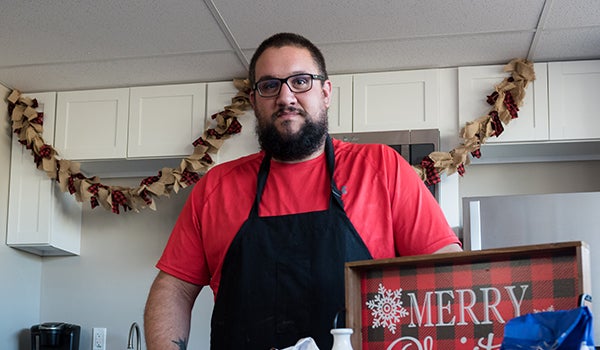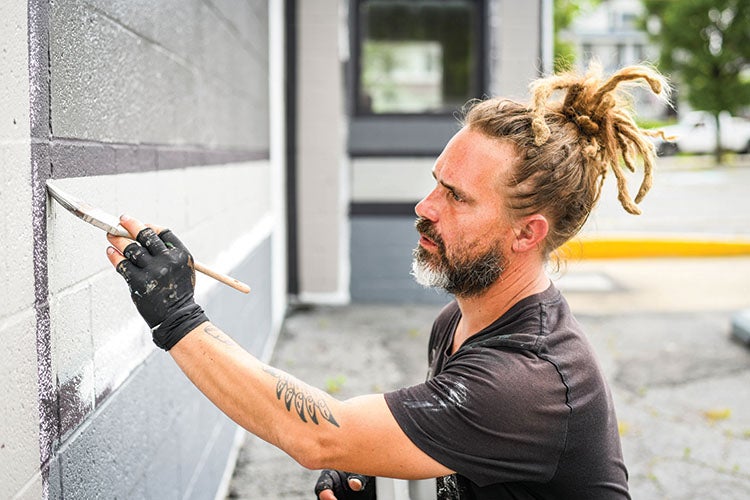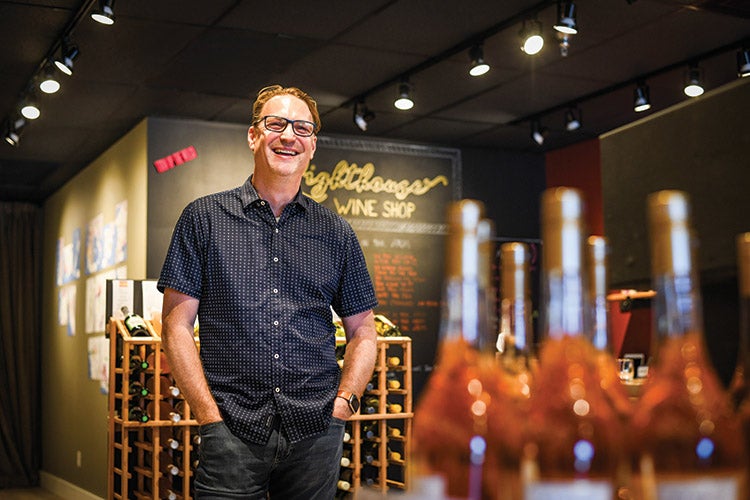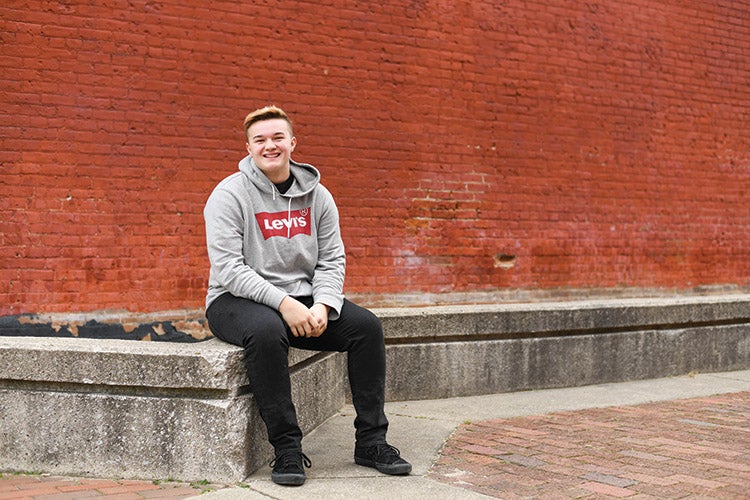Photography by Wes Jerdon/Westley Leon Studios
On Dec. 6, 2018, as the Brandywine wrestling team celebrated its season opener at Bronson High School, Searra Iman’s nerves were palpable. Though she would not be facing an opponent, she had a feat to conquer: making it onto the mat.
When her weight class was called, Searra approached the mat, exited her wheelchair, and army-crawled to the center circle, the gym near silent. When she reached the middle and the official raised her arm in victory, the crowd erupted in applause. Searra’s smile lit up the gymnasium.
“I had thought about not going out on the mat that first wrestling meet, because I didn’t know what was going to happen,” Searra says several months later. “I felt awkward and weird going out on the mat and crawling, but after I went out and everybody was clapping, it turned into more of something that I didn’t let scare me. I just went for it.”
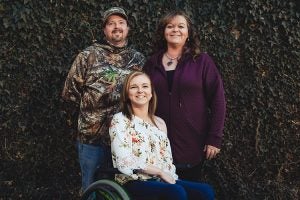 Twenty-six more times this wrestling season, Searra went for it. With gentle encouragement from Brandywine wrestling coach Rex Pomranka, opposing schools from all over southwest Michigan forfeited Searra’s weight class, giving the senior the opportunity to reach the 100-win mark that wrestlers covet.
Twenty-six more times this wrestling season, Searra went for it. With gentle encouragement from Brandywine wrestling coach Rex Pomranka, opposing schools from all over southwest Michigan forfeited Searra’s weight class, giving the senior the opportunity to reach the 100-win mark that wrestlers covet.
THE ACCIDENT
On the back of a silver motorcycle on a summer afternoon, Searra was enjoying the view as the motorcycle driver cruised east on U.S. 12. on the way to a bank, where Searra planned to open a new checking account.
“I looked forward and saw there was a car, and it was going across [the U.S. 31 Bypass northbound exit ramp], and I thought it would make it, so I didn’t think anything of it,” Searra says.
Witnesses told emergency personnel that a car driven by a 23-year-old South Bend resident pulled out in front of the motorcycle, and the motorcyclist did not have time to stop.
Searra was thrown from the motorcycle into the car, severing her spinal cord and leaving her with a broken arm, a broken femur and a broken jaw, among other injuries.
“When we first walked in her room, her head was huge and her left eye was really swollen,” says Searra’s dad, Chris Inman. “You could tell she was in really, really bad shape. They had tubes in her everywhere, and they were still working really hard. … Immediately they told us she may not make it, and they said, ‘she may be paralyzed.’”
The words, heart-breaking for any parent, provided just the perspective Searra’s mom, Pepper Inman, needed.
“Pepper turned and she was crying of course, and she said, ‘I don’t care [if she’s paralyzed]. I don’t care what doesn’t work. I don’t care how bad she is. She’s still here,’” Chris says.
Chris and Searra had made a pact before her accident that they would be open and honest with each other about any challenges they faced, so as his daughter went in and out of sleep, Chris struggled with not telling her she was paralyzed.
As it turned out, nobody needed to tell Searra. In her stupor, she figured it out on her own.
“I looked over at my dad and said, ‘I’m paralyzed, aren’t I?’” Searra recalls. When her dad confirmed, she said, “That’s OK. I’m going to walk again. I’m not sitting in a wheelchair the rest of my life.”
Pepper matched her daughter’s attitude.
“You can tell us she’s paralyzed, but that doesn’t mean anything is changing for her as far as her goals and what she wants to accomplish,” Pepper says.
A STUBBORN STREAK
Four years ago, Searra signed up for the wrestling team at Brandywine as a way to, as Pepper says, “channel some of her energy.” She playfully describes her daughter having a desire to challenge authority and test boundaries. Pepper and Chris thought the contact sport would allow Searra to release some of those feelings.
Searra fell in love.
In Coach Pomranka’s 15 years as head coach of the wrestling team, he had never coached a girl in the typically all-male sport. Because of Title IX, females wishing to wrestle may try out alongside male wrestlers, but that does not mean the other wrestlers are open to the idea of having a girl join their team.
But that did not stop Searra. She not only went out for the sport, but, going into her senior year, she had more than 70 wins.
The same stubborn streak that made Searra determined to join the team, and that later gave her the courage to keep working toward the 100 wins, is the stubborn streak that Searra and her family say have gotten her through her accident.
“I finally came to the realization when I was looking at Searra in the hospital, all those things that annoyed me about your personality that I was always trying to fix: your constant debating with me because you’re always right, or the constant arguments because you have to be right,” Pepper says. “I spent so much time thinking I needed to change that, but when the accident occurred, I was like, ‘I can’t believe how blessed we are that that’s her personality.’”
That fierce resolve is why Searra is where she is today. Less than two months after her accident — with two surgeries and an extensive surgery in Indianapolis and two weeks of therapy at Mary Free Bed behind her — Searra went home four months ahead of schedule.
SURVIVE AND ADAPT
Much like her sister Mikayla, a motocross athlete, Searra is a daredevil. She enjoys a thrill and has a bucket list of sports she would like to try, in addition to her goal of becoming a veterinarian.
“I thought I had it all planned out, and basically everything was all in line, but then something happens and then you have two options,” Searra says. “It’s either all downhill, or it’s a fork in the road. And you have to choose which one you’re going to go for.”
Since Searra’s accident, Chris has made it his mission to be sure that Searra can still enjoy the hobbies she enjoyed before. When Searra realized she could no longer access the family boat, Chris and Pepper found an even better, handicapped-accessible boat, sold the old one and came out even pricewise.
When hunting season approached, Chris created a special hunting blind for Searra.
“It was a couple days before hunting season, and I told Pepper, ‘I don’t care what it takes, I don’t care how I’m going to do it, but it’ll be done, so she sees that we are going to do everything we can to help her,’” Chris says. “There’s nothing that she can’t do because of this limitation.”
Since the accident, Searra’s bucket list has only gotten longer.
“I’ve done more things in my wheelchair than I have outside my wheelchair,” Searra said.
Earlier this year, Searra learned adaptive skiing, which allows paraplegic athletes to ski without their wheelchairs.
“One of the instructors told me I learned in two days what it took him to learn in eight years, so that was fun,” Searra says.
The experience was so fun that Searra now plans to try adaptive cycling, waterskiing and skydiving, too. Eventually, she and a friend intend to cycle the Boston Marathon.
“The thing that summed that up for us is Searra being in the wheelchair, you look at it, and you think ‘here are the limits. We have limits,’” Pepper says. “But what her being in the wheelchair has opened up all of our eyes to, and especially hers, is how limitless everything is for her now. While it seems limiting, and she has this limit, it just really has made us realize how limitless everything is.”


